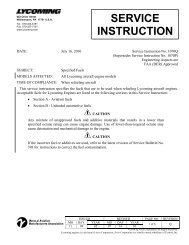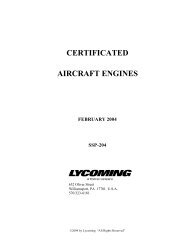You also want an ePaper? Increase the reach of your titles
YUMPU automatically turns print PDFs into web optimized ePapers that Google loves.
Detonation is a phenomenon which can occur in any internal<br />
combustion engine. The possibility of detonation cannot<br />
be completely eliminated. By definition, detonation is a violent<br />
explosion. When used with reference to a spark ignition<br />
internal combustion engine like the <strong>Lycoming</strong> aircraft<br />
piston engines, detonation indicates abnormal combustion.<br />
Essentially, detonation is an uncontrolled explosion of the<br />
unburned gases in the engine combustion chamber. Some<br />
engines are more susceptible to detonation than others. For<br />
example, turbocharged engines are more susceptible than similar<br />
non-turbocharged models and engines with higher compression<br />
ratios are more likely to exhibit detonation than engines with<br />
lower compression ratios.<br />
Detonation may occur in an aircraft engine as a result of maintaining<br />
a manifold pressure that is too high for the specific<br />
engine speed and mixture setting being used. The engine power<br />
(i.e., speed and manifold pressure) and mixture settings recommended<br />
in the Pilot’s Operating Handbook (POH) for a particular<br />
aircraft model have been determined by a detonation<br />
survey. These surveys use special instrumentation to detect<br />
and record detonation as it occurs. Based on these surveys, the<br />
detonation-limiting conditions are defined. Data from the surveys<br />
indicate that detonation occurs in varying degrees; it is<br />
sometimes possible to operate an engine for relatively long<br />
periods in the first minor phase of detonation without inducing<br />
damage. <strong>Lycoming</strong> does not recommend or condone engine<br />
operation which even approaches conditions which might cause<br />
detonation. The laboratory quality equipment used for the<br />
detonation survey is not practical for use in an aircraft engaged<br />
in normal flight operations. Without this equipment, the pilot<br />
may not know that detonation is occurring, and it is impossible to<br />
establish the fine line between the first phase of minor detonation<br />
and the detonation magnitude which induces preignition and/or<br />
engine damage. For this reason, it is imperative that power and<br />
mixture recommendations of the POH be carefully observed.<br />
Preignition is a circumstance that causes destructive engine<br />
damage and will be examined here briefly. Most <strong>Lycoming</strong><br />
engines are designed for ignition of the fuel/air mixture at<br />
20 crankshaft angle degrees (CAD) before the piston reaches<br />
top dead center during the compression stroke. Some engine<br />
models specify ignition at 18, 23, or 25 CAD before top dead<br />
center. If ignition of the fuel/air mixture occurs before the<br />
scheduled point in the operational sequence of events, preignition<br />
exists and the compression stroke continues as the burning<br />
fuel/air mixture is trying to expand. This subjects the combustion<br />
chamber and pistons to temperatures and pressures far in<br />
excess of those experienced during normal combustion. These<br />
excessive temperatures and pressures cause damage to pistons<br />
and valves. In some cases, both burned pistons and stretched<br />
valves will be found in an engine which has been subjected<br />
to preignition.<br />
Considering the millions of hours flown each year in<br />
piston-powered aircraft, engine damage from detonation and<br />
preignition is quite rare. The infrequency of this happening<br />
means little if your engine is the one affected. Therefore, it seems<br />
appropriate to look more closely at some of the factors which lead<br />
to detonation and preignition.<br />
L y c o m i n g F l y e r<br />
The possibility of overboost is a characteristic of all supercharged<br />
and turbocharged engines. Generally, overboost<br />
means the application of manifold pressure which exceeds the<br />
limit specified by the manufacturer. Early versions of the<br />
manually controlled turbocharger allowed quite a few pilots to<br />
inadvertently induce damage by overboost. With this system, the<br />
turbocharger wastegate was normally left full open for<br />
takeoff; full throttle would produce 28 to 30" of manifold pressure.<br />
After takeoff at full throttle, gradual closing of the<br />
wastegate would slowly increase turbocharger speed and manifold<br />
pressure to maintain climb power to cruise altitude or<br />
to the critical altitude of the engine. The system worked fine until<br />
the wastegate was inadvertently left in the closed position. If the pilot<br />
then applied full throttle for takeoff or a go-round, it could produce<br />
60" or more of manifold pressure and failure of the engine.<br />
More recent turbocharger installations usually include a pressure<br />
relief valve and/or an automatic wastegate control which<br />
helps to avoid the possibility of overboost. Even with these protective<br />
devices, it is still possible to overboost by rapid throttle<br />
operation and/or inattention to limiting manifold pressures<br />
at low engine speeds.<br />
Automatic controllers may not be capable of preventing overboost<br />
if full throttle operation is attempted before engine oil<br />
is warmed up sufficiently. <strong>Lycoming</strong> Service Bulletin 369F<br />
addresses the problem of overboost and recommends, depending<br />
on the severity and duration of the overboost, a log-book entry,<br />
engine inspection or complete engine overhaul including replacement<br />
of the crankshaft.<br />
As stated earlier, ignition of the fuel/air mixture must take<br />
place at precisely the right time. A spark plug which has been<br />
dropped, or damaged in some other way, may induce preignition<br />
by causing a “hot spot” in the combustion chamber which<br />
self-ignites the fuel/air mixture. This could also occur from<br />
use of unapproved spark plugs. Flight with defective magnetos<br />
or flight in excess of certified aircraft limits may allow<br />
cross-firing within the magneto, improperly sequenced ignition<br />
of the fuel/air mixture and engine damage. Proper magneto<br />
engine timing is also an important factor. The timing is affected<br />
by wear and therefore should be checked and reset at specified<br />
intervals. Regular, meticulous spark plug and magneto maintenance<br />
will help to avoid preignition and possible engine damage<br />
from these sources.<br />
Although overboost and incorrect ignition timing are causes<br />
of induced engine damage, this damage can often be attributed<br />
to fuel and the fuel/air mixture. The first problem related<br />
to fuel is simply having improper fuel in the aircraft tanks.<br />
A piston-powered aircraft refueled with jet fuel would have a fuel<br />
blend with greatly reduced octane level. A piston engine should<br />
not be started when even small amounts of jet fuel have been<br />
added to aviation gasoline because engine contamination and<br />
detonation are likely; attempted flight under these conditions will<br />
certainly result in destructive detonation and preignition. The use<br />
of 80 octane aviation fuel in an engine certified for 100 octane<br />
aviation fuel will produce similar results.<br />
The lubricating oil may be a source of octane reducing fuel contamination.<br />
Excessively worn piston rings may allow enough oil into







